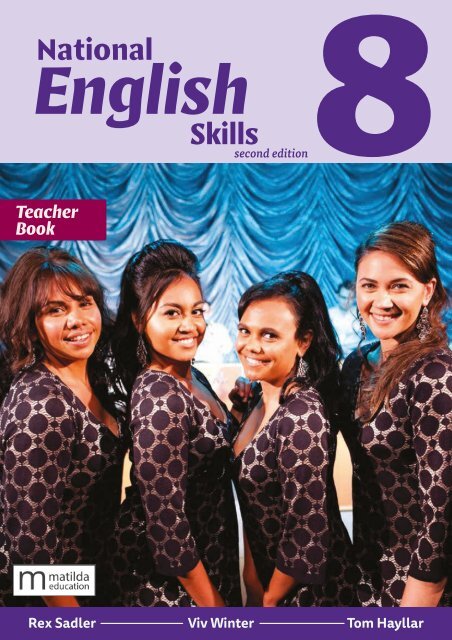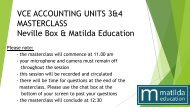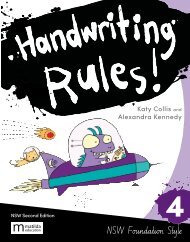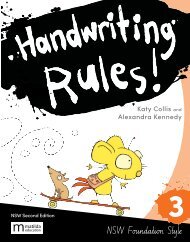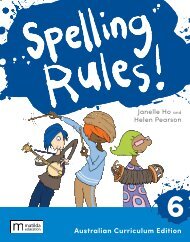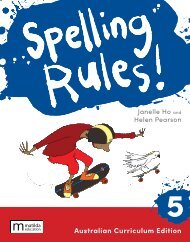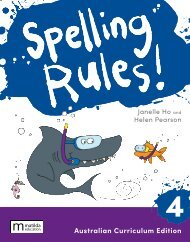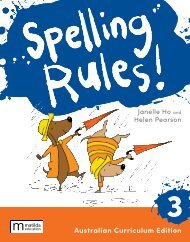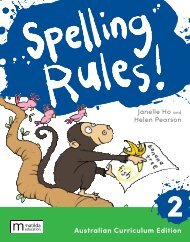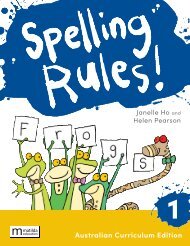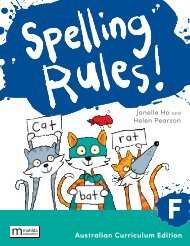National English Skills 8 2E Teacher Book Sample Pages
You also want an ePaper? Increase the reach of your titles
YUMPU automatically turns print PDFs into web optimized ePapers that Google loves.
<strong>National</strong><br />
<strong>English</strong><br />
<strong>Skills</strong><br />
second edition<br />
<strong>Teacher</strong><br />
<strong>Book</strong><br />
Rex Sadler<br />
Viv Winter<br />
Tom Hayllar
<strong>National</strong><br />
<strong>English</strong><br />
<strong>Skills</strong><br />
second edition<br />
<strong>Teacher</strong> Student<br />
<strong>Book</strong> Workbook<br />
Rex Sadler<br />
Viv Winter<br />
Tom Hayllar
<strong>National</strong> <strong>English</strong> <strong>Skills</strong> 8<br />
second edition<br />
Rex Sadler<br />
Viv Winter<br />
Tom Hayllar<br />
This edition was published in 2023 by<br />
Matilda Education Australia,<br />
an imprint of Meanwhile Education Pty Ltd<br />
Melbourne, Australia<br />
T: 1300 277 235<br />
E: customersupport@matildaed.com.au<br />
www.matildaeducation.com.au<br />
First edition published in 2011 by Macmillan Science and<br />
Education Australia Pty Ltd<br />
Second edition published in 2023 by Matilda<br />
Education Australia<br />
Copyright © Rex Sadler, Viv Winter, Tom Hayllar 2011, 2023<br />
The moral rights of the authors have been asserted.<br />
Publisher: Melinda Schumann<br />
Illustrators: Tracie Grimwood, Chris Dent<br />
Permissions researcher: Samantha Russell-Tulip<br />
Cover and text designer, typesetter: Beau Lowenstern<br />
Typeset in Tisa Pro and Tisa Sans Pro<br />
Cover image: The Sapphires, Goalpost Pictures (2012),<br />
Image courtesy of Goalpost Pictures. Photograph: Alamy<br />
Stock Photo/Pictorial Press Ltd<br />
All rights reserved. Except under the conditions described<br />
in the Copyright Act 1968 of Australia (the Act) and<br />
subsequent amendments, no part of this publication may<br />
be reproduced, in any form or by any means, without the<br />
prior written permission of the copyright owner.<br />
Educational institutions copying any part of this book for<br />
educational purposes under the Act must be covered by a<br />
Copyright Agency Limited (CAL) licence for educational<br />
institutions and must have given a remuneration notice<br />
to CAL.<br />
These limitations include: restricting the copying to a<br />
maximum of one chapter or 10% of this book, whichever<br />
is greater. For details of the CAL licence for educational<br />
institutions, please contact:<br />
Copyright Agency Limited<br />
Level 11, 66 Goulburn Street<br />
Sydney, NSW 2000<br />
Toll-free phone number (landlines only): 1800066844<br />
Telephone: (02) 9394 7600<br />
Fax (02) 9394 7601.<br />
Email: memberservices@copyright.comau<br />
Website: https://www.copyright.com.au<br />
Publication data<br />
Author: Rex Sadler, Viv Winter, Tom Hayllar<br />
Title: <strong>National</strong> <strong>English</strong> <strong>Skills</strong> 8 2e Student <strong>Teacher</strong> <strong>Book</strong> Workbook<br />
ISBN: 978-0-6550-9213-1<br />
978-0-6550-9217-9<br />
Warning: It is recommended that Aboriginal and<br />
Torres Strait Islander peoples exercise caution when<br />
viewing this publication as it may contain images of<br />
deceased persons.<br />
Printed in Malaysia Australia by Vivar Printing<br />
by Courtney Brands<br />
Sep-2022
Contents<br />
Prefacevii<br />
1<br />
2<br />
3<br />
4<br />
5<br />
Acknowledgmentsvii<br />
Culture and identity 1<br />
Beliefs and values 1<br />
The Whale Rider<br />
Language and identity 3<br />
Growing up Asian in Australia<br />
Language Clauses 6<br />
Visual texts 9<br />
What is a visual text? 9<br />
Making visual choices 9<br />
Photographs10<br />
Movie poster 12<br />
Avatar<br />
Picture book 14<br />
Beneath the Surface<br />
Aboriginal perspectives 19<br />
Memories and experiences 19<br />
Stradbroke Dreamtime<br />
‘The black rat’<br />
Language Nouns 24<br />
Points of view 27<br />
What is a point of view? 27<br />
First person 27<br />
Don’t Look Behind You, But …<br />
Second person 29<br />
The Other Side of Dawn<br />
Third person 31<br />
Brisingr<br />
Changing the point of view 33<br />
Whitney Darrow cartoon<br />
Language Personal pronouns 35<br />
Multimodal texts 37<br />
What are multimodal texts? 37<br />
Memoir and painting 37<br />
South<br />
Novel and film poster 39<br />
The Hobbit<br />
Biography and film still 42<br />
Follow the Rabbit-Proof Fence<br />
Contents<br />
iii
6<br />
7<br />
8<br />
9<br />
10<br />
11<br />
Advertising 45<br />
What is advertising? 45<br />
Persuasive techniques 45<br />
Magazine advertisement 46<br />
Ingham turkey<br />
‘Let nature be your guide’ advertisement 48<br />
Cleland Wildlife Park<br />
‘Being a good egg’ campaign 50<br />
Transperth public transport<br />
Language Persuasion 53<br />
Improve your spelling 55<br />
Silent letters 55<br />
Syllables57<br />
Spelling guides 58<br />
Difficult pairs 61<br />
Hard-to-spell words 62<br />
Breaking news 64<br />
What is a news report? 64<br />
Structure of a news report 64<br />
News reports 65<br />
‘Teen’s miracle crash’<br />
‘Reef on path to destruction …’<br />
Cartoon69<br />
‘Barrier grief’<br />
Headlines70<br />
Exploring stories 72<br />
What is a short story? 72<br />
Key elements of the short story 72<br />
A twist in the tale 73<br />
‘The three wishes’<br />
‘The Copy’<br />
Autobiography 82<br />
What is an autobiography? 82<br />
Growing up in China 82<br />
Chinese Cinderella<br />
Attack in Afghanistan 85<br />
The Rugmaker of Mazar-e-Sharif<br />
Language Verbs 88<br />
Write now 92<br />
How to become a better writer 92<br />
Saving our planet 93<br />
Describing a character 94<br />
Writing a movie review 95<br />
Favourites96<br />
iv<br />
Contents
Genres – setting 97<br />
What if …? 98<br />
Conflict99<br />
12<br />
13<br />
14<br />
15<br />
The novel 100<br />
What is a novel? 100<br />
The cover 100<br />
The Barrumbi Kids<br />
Character102<br />
A Bridge to Wiseman’s Cove<br />
Setting103<br />
Holes<br />
Cultural context 106<br />
The Barrumbi Kids<br />
Conflict109<br />
Goodnight, Mister Tom<br />
The language of poetry 114<br />
What is figurative language? 114<br />
Similes114<br />
‘Symphony in yellow’<br />
Metaphors115<br />
‘Tractor’<br />
Hyperbole116<br />
‘My love is like a red, red rose’<br />
Personification117<br />
‘Winter’<br />
Onomatopoeia118<br />
‘Sounds’<br />
Alliteration121<br />
‘The Mikado’<br />
'Kubla Khan'<br />
Assonance122<br />
Symbols in poetry 122<br />
'The kangaroo’<br />
The power of words 125<br />
Tone125<br />
Rhetorical questions 126<br />
W Churchill, ‘Speech to the House of Commons’<br />
Vocabulary128<br />
Humour 131<br />
What is humour? 131<br />
The pun 131<br />
Cartoon humour 133<br />
‘Aliens invade earth’<br />
Contents<br />
v
16<br />
17<br />
18<br />
19<br />
20<br />
Parody134<br />
Nursery rhymes<br />
A funny poem 136<br />
‘Excuses, excuses’<br />
Science fiction 138<br />
What is science fiction? 138<br />
Reading a science fiction story 138<br />
‘Zoo’<br />
Language Prefixes and suffixes 142<br />
Let’s punctuate 146<br />
Apostrophes146<br />
Abbreviations149<br />
Quotation marks used for titles 151<br />
Colons153<br />
Semicolons154<br />
Drama 155<br />
What is drama? 155<br />
Features of a play 155<br />
Script and dialogue 156<br />
Macbeth<br />
Coming to terms with drama 158<br />
So Much to Tell You: The Play<br />
Relationships in drama 162<br />
Lockie Leonard, Human Torpedo<br />
Speaking out 166<br />
What is speaking out? 166<br />
Inconvenient truths 166<br />
‘World problems’<br />
Talkback radio 169<br />
‘Schoolies Week vandalism’<br />
Language Adjectives 172<br />
Using paragraphs 175<br />
What is a paragraph? 175<br />
Structure of a paragraph 175<br />
‘Saying “No” to bullying’<br />
Expressing a point of view 177<br />
‘Should school uniforms be abolished?’<br />
Text connectives 178<br />
Language Nominalisation and revising parts of speech 180<br />
Back-of-the-book dictionary 184<br />
vi<br />
Contents
Preface<br />
<strong>National</strong> <strong>English</strong> <strong>Skills</strong> 8, second edition, has been fully revised to reflect the content descriptions of<br />
the Australian Curriculum: <strong>English</strong>, Version 9.0. It offers a practical, skills-based approach to the<br />
Language, Literature and Literacy strands, with a strong focus on developing the reading, viewing,<br />
writing, speaking and listening skills that are at the heart of the curriculum.<br />
The workbook seeks, through a diversity of high-interest texts, to engage the interest of students<br />
and to enrich their <strong>English</strong> experience. In addition to literary and non-literary texts, it draws on a<br />
variety of multimodal resources from newspapers, films, advertising, the internet and more.<br />
Texts have been carefully chosen to represent a wide range of cultural perspectives, including<br />
First Nations.<br />
The sections within each unit are self-contained, allowing them to be incorporated easily<br />
into existing teaching programs. Comprehension and language exercises are suitable for both<br />
classroom and homework tasks. Opportunities are provided throughout the workbook for students<br />
to create their own written, spoken and multimodal texts.<br />
<strong>National</strong> <strong>English</strong> <strong>Skills</strong> 8, second edition, includes two completely new units:<br />
●<br />
●<br />
Unit 5: Multimodal texts<br />
Unit 11: Write now.<br />
Acknowledgments<br />
The author and publisher are grateful to the following for permission to reproduce copyright material:<br />
PHOTOGRAPHS<br />
Alamy Stock Photo/Andy Rouse/Bluegreen Pictures, 93, /<br />
Entertainment Pictures, 1, 43, /Everett Collection Inc, 12, /Ezyjoe,<br />
113, /Genevieve Vallee, 180, /Matt Brown, 8, /New Line Cinema/<br />
AF archive, 41, /New Line Cinema/Allstar Picture Library Ltd., 94, /<br />
Pictorial Press Ltd, 95, /Stefan Schurr/Westend61 GmbH, 10 (top),<br />
/Universal/AA Film Archive, 97; Getty Images/Attila Kisbenedek/<br />
AFP, 71, / Bradley Kanaris, 169, /Brett Munroe, 67 (top), /john<br />
finney photography, 129, /Nicky Dowling, 106, /Royal Geographical<br />
Society, 38; iStockphoto/1BSG, 99, /35007, 107, /Adam Calaitzis,<br />
5, /AK2, 174, /alice-photo, 146, /Andreyuu, 26, /Anna Frank, 179,<br />
/Antonio_Diaz, 175, /ArtMarie, 118, /AscentXmedia, 52, /brazzo,<br />
73, /Breigouze, 139, /by_nicholas, 30, /CampPhoto, 90, /cinoby,<br />
104, /damircudic, 112, /dja65, 55, /DNY59, 152, /DuxX, 115, /<br />
Elenathewise, 24, /EmiSta, 149, /fcafotodigital, 53, /Givaga, 2, /<br />
gprentice, 182, /Grafissimo, 170, /gregepperson, 58, /iculizard, 45,<br />
/igor_kell, 145, /Imgorthand, 96, /inhauscreative, 89, /keiichihiki,<br />
181, /kurga, 114, /lindsay_imagery, 167, , /Mauricio Graiki, 17<br />
(bottom), /mevans, 16, /millionhope, 164, /MKucova, 148, /<br />
monkeybusinessimages, 177, /Paperkites, 70, /Paula Jones, 67<br />
(bottom), /peeterv, 110, /Pleasureofart, 151, /photomaru, 56–7, /<br />
proxyminder, 122, /pxel66, 119, /richcano, 161, /Robert Daly, 143, /<br />
RomoloTavani, 98, /RoschetzkyIstockPhoto, 11, /samvaltenbergs,<br />
54, /SurkovDimitri, 17 (top), /timsa, 61, /Uwe-Bergwitz, 183, /<br />
WLDavies, 10 (bottom); Sam Rosewarne/Newspix, 65; Unsplash/<br />
Abdul A, 147, /Alessandro Cerino, 127, /Stephen Tafra, 20.<br />
OTHER MATERIAL<br />
Extract and cover from Don’t Look Behind You, But …. , by Peter<br />
Allison, reprinted by permission by Allen & Unwin, 2009, pp.<br />
27–8; Poem ‘Tractor’ by William Hart-Smith, reproduced with<br />
permission from the Australian Society of Authors, 115; Extract and<br />
cover Extract and cover © Louis Sachar, 2015, Holes, Bloomsbury<br />
Publishing Plc, 103–4; Cartoon, Pat Campbell, 69; Extract and<br />
cover from “The Relative Advantages of Learning My Language”<br />
from Growing Up Asian in Australia by Ami Choi, edited by Alice<br />
Pung/Black Inc, 3–4; Advertisement, Cleland Wildlife Park ©<br />
South Australian Department of Environment and Water. Creative<br />
agency: Showpony, 48; Article, ‘Teen’s miracle crash’, by Danielle<br />
McKay, The Herald Sun, 5 April 2010. The use of this work has been<br />
licensed by Copyright Agency except as permitted by the Copyright<br />
Act, you must not re-use this work without the permission of the<br />
copyright owner or Copyright Agency, 65; Article extract, ‘Reef<br />
on path to destruction and ‘clever science can’t fix it’, by Mike<br />
Foley, Brisbane Times, 8 April 2021. The use of this work has been<br />
licensed by Copyright Agency except as permitted by the Copyright<br />
Preface<br />
vii
Act, you must not re-use this work without the permission of the<br />
copyright owner or Copyright Agency, 67;Extract and cover from<br />
Lockie Leonard, Human Torpedo, Playscript by Paige Gibbs, adapted<br />
from the novel by Tim Winton © Paige Gibbs and Tim Winton 1996.<br />
Reproduced with permission from Currency Press Pty Ltd, Sydney<br />
Australia, 162–3; Extract from Winston Churchill’s ‘Blood, toil, tears<br />
and sweat’ speech, 13 May 1940, House of Commons. Reproduced<br />
with permission of Curtis Brown, London on behalf of the Estate<br />
of Sir Winston Churchill. Copyright © Winston S. Churchill, 127;<br />
Double-page spread, Image reprinted with permission from<br />
Beneath the Surface by Gary Crew, 2005, 103–4; Image and<br />
extracts reprinted with permission from So Much to Tell You - The<br />
Play by John Marsden, Hachette Australia, 1994, 158–60; Extract<br />
and cover from Stradbroke Dreamtime by Oodgeroo, Nunukul,<br />
1972, reprinted with permission by HarperCollins Publishers,<br />
19–21; Extracts from The Hobbit by J. R. R. Tolkien. Reprinted by<br />
permission of HarperCollins Publishers Ltd © 1937 J. R. R. Tolkien,<br />
40, 94; Advertisement, Ingham’s, the Ingham’s logo and the Always<br />
Good Guaranteed logo are trademarks of Ingham’s Enterprises PTY<br />
LTD, 46; Extracts from The Barrumbi Kids by Leonie Norrington,<br />
Omnibus <strong>Book</strong>s/Scholastic Australia, reproduced with permission,<br />
106–7; Cartoon, Mark Lynch, 133; Poem ‘Sounds’ by Brian<br />
Moses, from Hippopotamus Dancing and Other Poems, Cambridge<br />
University Press. Reproduced by permission of the author, 119;<br />
Poem, WINTER c Judith Nicholls 1987, from MIDNIGHT FOREST<br />
by Judith Nicholls, pub. Faber and Faber. Reprinted by permission<br />
of the author, 116–7; Extract and cover from The Other side of<br />
Dawn by John Marsden, reprinted by permission of Pan Macmillan<br />
Australia Pty Ltd. Copyright © John Marsden 1999, 29; Extract from<br />
The Whale Rider by Witi Ihimaera. Copyright © Witi Ihimaera. First<br />
published by Raupo, 2008. Reprinted by permission of Penguin<br />
Random House Australia Pty Ltd., 2; Poem ‘The Black Rat’ by<br />
Iris Clayton from Inside Black Australia, edited by Kevin Gilbert,<br />
Penguin, 1988. First published by Penguin, 1988. Reprinted by<br />
permission of Penguin Random House Australia Pty Ltd., 22–3;<br />
Short story ‘The Copy’, and cover from Quirky Tails by Paul Jennings.<br />
Copyright © Paul Jennings. First published by Puffin <strong>Book</strong>s, 1987.<br />
Reprinted by permission of Penguin Random House Australia<br />
Pty Ltd., 74–80; Extract and cover from Chinese Cinderella by<br />
Adeline Yen Mah. Copyright © Adeline Yen Mah. First published<br />
by Penguin Australia, 1999. Reprinted by permission of Penguin<br />
Random House Australia Pty Ltd., 82–3;Artwork and Text from<br />
Goodnight Mister Tom by Michelle Magorian. Text Copyright ©<br />
Michelle Magorian, 1981, 2001. First published in Kestrel <strong>Book</strong>s,<br />
1981, Puffin <strong>Book</strong>s 1983, 2014, 2021. Reprinted by permission of<br />
Penguin <strong>Book</strong>s Limited, 109–10;Artwork and Extract from Brisingr:<br />
<strong>Book</strong> Three by Christopher Paolini. Copyright © Christopher Paolini,<br />
2008. Jacket Art Copyright © John Jude Palencar, 2005. Published<br />
in Great Britain by Doubleday, 2008, Corgi <strong>Book</strong>s, 2009. Reprinted<br />
by permission of The Random House Group Limited, 31; Poem,<br />
‘Excuses, Excuses’ by Gareth Owen. Copyright © Gareth Owen.<br />
Reproduced by permission of the author c/o Rogers, Coleridge<br />
& White Ltd., 20 Powis Mews, London W11 1JN, 136; Cover, from<br />
The Barrumbi Kids by Leonie Norrington. Text copyright © Leonie<br />
Norrington, 2002. Cover artwork copyright © Vivienne Goodman.<br />
First published by Omnibus <strong>Book</strong>s, a division of Scholastic<br />
Australia, 2002. Reproduced by permission of Scholastic Australia<br />
Pty Ltd., 100; Short story ‘Zoo’ by Edward D Hoch, originally<br />
appeared in Fantastic Universe Magazine, June 1958; reprinted by<br />
permission of the Ed Hoch Estate and the Sternig & Byrne Literary<br />
Agency, 138–9; <strong>Book</strong> cover designed by Stella Danalis, 102; Images<br />
courtesy of Transperth, 50–1; Extract from Follow the Rabbit-Proof<br />
Fence by Doris Pilkington/Nugi Garimara, UQP, 2002, 42–3; Extract<br />
from A Bridge to Wiseman’s Cove by James Moloney, UQP, 1996,<br />
102; Extract and cover from The Rugmaker of Mazar-E-Sharif [Najaf<br />
Mazari and Robert Hillman, 2008], reproduced with permission of<br />
Wild Dingo Press, 85–6.<br />
The author and publisher would like to acknowledge the following:<br />
Poem ‘The Black Rat’ by Iris Clayton from Inside Black Australia,<br />
edited by Kevin Gilbert, Penguin, 1988. First published by Penguin,<br />
1988, 22–3; Cartoon by Darrow, Jr., Whitney, The New Yorker<br />
Magazine, Inc., 1979, 33; Poem, ‘The Kangaroo’ by James Hackson,<br />
copyright James Hackson, 123.<br />
Every effort has been made to identify copyright holders and obtain their permission for the use of copyright material.<br />
We actively solicit copyright holders or anyone with knowledge of copyright holders to come forward.<br />
viii<br />
Acknowledgments
1<br />
Culture<br />
and identity<br />
Every society or group has its own cultural traditions and values. Sometimes these are lost over<br />
time as the effect of progress detaches individuals from their heritage. As individuals, we also<br />
need to establish our own identity, or sense of self, if our lives are to have meaning. These ideas are<br />
explored in the following extracts.<br />
Beliefs and values<br />
The Whale Rider<br />
The novel The Whale Rider was written in 1986 by Witi Ihimaera, a well-known Maori writer.<br />
From the start of the novel the reader is aware that the main character, the young girl Kahu, is<br />
special. In the following extract, late in the novel, Kahu is fulfilling her destiny by showing that<br />
she is at one with the whales and can reconnect her people with their traditional cultural beliefs<br />
and values. The extract mentions Kahutia Te Rangi and Paikea, who are her ancestors.<br />
1: Culture and identity<br />
1
Riding the whale<br />
She was the whale rider. Astride the whale<br />
she felt the sting of the surf and rain upon her<br />
face. On either side the younger whales were<br />
escorting their leader through the surf. They<br />
broke into deeper water.<br />
Her heart was pounding. She saw that now<br />
she was surrounded by the whale herd. Every<br />
now and then, one of the whales would come to<br />
rub against the ancient leader. Slowly, the herd<br />
made its way to the open sea.<br />
She was Kahutia Te Rangi. She felt a shiver<br />
running down the whale and, instinctively, she<br />
placed her head against its skin and closed her<br />
eyes. The whale descended in a shallow dive and<br />
the water was like streaming silk. A few seconds<br />
later the whale surfaced, gently spouting.<br />
Her face was wet with sea and tears. The<br />
whales were gathering speed, leaving the<br />
land behind. She took a quick look and saw<br />
headlights far away. Then she felt the same<br />
shiver again, and again, placed her head<br />
against the whale’s skin. This time when the<br />
whale dived, it stayed underwater longer. But<br />
Kahu had made a discovery. Where her face<br />
was pressed the whale had opened up a small<br />
breathing chamber.<br />
She was Paikea. In the deepening ocean<br />
the fury of the storm was abating. The whale’s<br />
motions were stronger. As it rose from the sea,<br />
its spout was a silver jet in the night sky.<br />
Then it dived a third time, and the pressure on<br />
her eardrums indicated to the young girl that<br />
this was a longer dive than the first two had<br />
been. And she knew that the next time would<br />
be forever.<br />
She was serene. When the whale broke the<br />
surface she made her karanga to sky and earth<br />
and sea and land. She called her farewells to<br />
her iwi. She prepared herself as best she could<br />
with the little understanding she had. She said<br />
goodbye to her Paka, her Nanny, her father and<br />
mother, her Uncle Rawiri, and prayed for their<br />
good health always. She wanted them to live for<br />
ever and ever.<br />
The whale’s body tensed. The girl felt her feet<br />
being locked by strong muscles. The cavity for<br />
her face widened. The wind whipped at her hair.<br />
Suddenly the moon came out. Around her<br />
the girl could see whales sounding, sounding,<br />
sounding. She lowered her face into the whale<br />
and closed her eyes. ‘I am not afraid to die,’ she<br />
whispered to herself.<br />
The whale’s body arched and then slid into<br />
a steep dive. The water hissed and surged<br />
over the girl. The huge flukes seemed to stand<br />
on the surface of the sea, stroking at the<br />
rain-drenched sky. Then slowly, they too slid<br />
beneath the surface.<br />
She was Kahutia Te Rangi. She was Paikea.<br />
She was the whale rider.<br />
from The Whale Rider by Witi Ihimaera<br />
iwi<br />
karanga<br />
tribe<br />
call<br />
Reading for understanding<br />
1 What is the main action in the opening paragraph?<br />
Kahu is riding a whale out into the ocean escorted by younger whales.<br />
________________________________________________________________________________<br />
2 ‘Her heart was pounding.’ How does Kahu feel?<br />
She is feeling frightened and nervous.<br />
________________________________________________________________________________<br />
2 <strong>National</strong> <strong>English</strong> <strong>Skills</strong> 8
3 What instinctive movement does Kahu make when the whale shivers?<br />
She places her head against its skin and closes her eyes.<br />
________________________________________________________________________________<br />
4 What discovery does Kahu make when she presses her face against the whale as it dives deeper?<br />
She discovers that the whale has opened up a small breathing chamber.<br />
________________________________________________________________________________<br />
5 What did Kahu know when the whale dived even deeper for a third time?<br />
She knew that the next time would be forever.<br />
________________________________________________________________________________<br />
6 As she calls her farewells, how can you tell that Kahu feels an intensely deep love for her family?<br />
She prays for their health and wants them to live for ever and ever.<br />
________________________________________________________________________________<br />
7 Kahutia Te Rangi and Paikea are Kahu’s ancestors. What do you think the last sentence of<br />
the extract means?<br />
Kahu has become at one with her ancestors as she is now the whale rider.<br />
________________________________________________________________________________<br />
8 How would you describe the character of Kahu from this extract?<br />
She is determined, loyal and courageous. She believes deeply in the spiritual connections<br />
________________________________________________________________________________<br />
with the whales. She is willing to risk death in her attempt to save her people.<br />
________________________________________________________________________________<br />
Language and identity<br />
In this moving personal narrative, Amy Choi, a Chinese woman who has grown up in Australia,<br />
reflects on her relationship with her grandfather and how this defines her own sense of language,<br />
culture and identity.<br />
The relative advantages of learning my language<br />
I was never particularly kind to my grandfather.<br />
He was my mother’s father, and he lived with us<br />
when I was a teenager. I remember him coming<br />
into the lounge room one night, and when he<br />
went to sit down, I said to my brother, ‘I hope he<br />
doesn’t sit down.’ I didn’t think my grandfather<br />
understood much <strong>English</strong>, but he understood<br />
enough, and as I watched, he straightened<br />
up again, and without a word, returned to his<br />
room. I was twelve years old.<br />
My grandfather wrote poetry on great rolls of<br />
thin white paper with a paintbrush. He offered<br />
to read and explain his poems to me several<br />
times over the years, but I only let him do it<br />
once. I’d let my Chinese go by then, which made<br />
listening to him too much of an effort. Though<br />
I was raised speaking Chinese, it wasn’t long<br />
before I lost my language skills. I spoke <strong>English</strong><br />
all day at school, listened to <strong>English</strong> all night on<br />
TV. I didn’t see the point of speaking Chinese.<br />
We lived in Australia.<br />
Monday to Friday, Grandad went to the<br />
city, dressed in a suit with a waistcoat, a hat,<br />
and carrying his walking stick. He would take<br />
the bus to the station, the train to the city, the<br />
tram to Little Bourke Street. On Mondays,<br />
he’d be sitting at a large round table at Dragon<br />
Boat Restaurant with other old Chinese men.<br />
1: Culture and identity<br />
3
Tuesdays to Fridays, he was at a small square<br />
table by himself with a pot of tea and the<br />
Chinese newspaper. I watched him leave in the<br />
morning and come back in the afternoon, as<br />
punctual and as purposeful as any school kid or<br />
office worker, for years.<br />
One afternoon, he didn’t come home until<br />
well after dark. We assumed he’d got off the bus<br />
at the wrong stop or had turned into the wrong<br />
street at some point, forcing him to wander<br />
around for a bit before finding his way home.<br />
A month after that, he tried to let himself<br />
into a stranger’s house. It looked just like our<br />
house. The yellow rose bush, the painted timber<br />
mailbox, even the Ford Falcon parked out the<br />
front were the same. But it was the home of a<br />
gentle Pakistani couple who let him use the<br />
phone to call us.<br />
Two months after that, he fell and hit his<br />
head on something. When he didn’t come<br />
home, Mum and I drove around looking for<br />
him. We finally found him stumbling around in<br />
the dark, two kilometres from the house. There<br />
was a trickle of blood down the side of his face.<br />
From that day forward, Grandad was<br />
only allowed to go to the city if someone<br />
accompanied him. Once or twice during the<br />
school holidays that task fell to me.<br />
After rinsing out his milk glass, Grandad<br />
would pick up his walking stick and head out<br />
into the street. I’d follow, a few steps behind. He<br />
wasn’t aware of me. He wasn’t aware of the milk<br />
on his lip, the upside-down watch on his wrist,<br />
the scrape of branches against his coat. He had<br />
a blank, goofy, content expression on his face,<br />
and turned instinctively into platform five when<br />
he was at the train station and into Dragon Boat<br />
Restaurant when he was on Little Bourke Street.<br />
When he was about to board the wrong<br />
tram or turn around the wrong corner, I’d step<br />
forward to take him by the elbow and steer him<br />
back on course. He’d smile innocently and seem<br />
glad to see me. ‘Hello there, Amy. Finished<br />
school already?’ Then he’d look away and forget<br />
I was ever there.<br />
He’d been<br />
diagnosed with<br />
a brain tumour<br />
and, three months<br />
later, he died.<br />
At the funeral,<br />
my sadness was<br />
overshadowed by<br />
a sense of regret.<br />
I’d denied my<br />
grandfather the<br />
commonest of<br />
kindnesses. I was<br />
sixteen years old.<br />
I am now<br />
twenty-six. A few weeks ago, during a family<br />
dinner at a Chinese restaurant, the waiter<br />
complimented my mum on the fact that I was<br />
speaking to her in Chinese. The waiter told<br />
Mum with a sigh that his own kids could barely<br />
string a sentence together in Chinese. Mum<br />
told the waiter I had stopped speaking Chinese<br />
a few years into primary school, but that I had<br />
suddenly started up again in my late teens.<br />
I have often wondered how aware my mum<br />
is of the connection between Grandad’s death<br />
and my ever-improving Chinese. Whenever I<br />
am stuck for a word, I ask her. Whenever I am<br />
with her, or relatives, or a waiter at a Chinese<br />
restaurant, or a sales assistant at a Chinese<br />
department store, I practise. I am constantly<br />
adding new words to my Chinese vocabulary,<br />
and memorising phrases I can throw into a<br />
conversation at will. It is an organic way of<br />
relearning a language. Textbooks and teachers<br />
are not necessary, since I am only interested in<br />
mastering the spoken word. I am not interested<br />
in the written word or in the many elements of<br />
Chinese culture of which I am ignorant. I am<br />
not trying to ‘discover my roots’. I am simply<br />
trying to ensure that the next time an elderly<br />
relative wants me to listen to them, I am not<br />
only willing, I am able.<br />
by Amy Choi, from Growing up Asian in Australia,<br />
edited by Alice Pung<br />
4 <strong>National</strong> <strong>English</strong> <strong>Skills</strong> 8
Reading for understanding<br />
1 ‘I was never particularly kind to my grandfather.’ Why is this opening sentence effective?<br />
The writer has made a clear statement that is open, honest and self-critical.<br />
________________________________________________________________________________<br />
2 What example of unkindness to her grandfather does the writer give in the first paragraph?<br />
When her grandfather comes into the lounge room she says that she hopes he<br />
________________________________________________________________________________<br />
doesn’t sit down.<br />
________________________________________________________________________________<br />
3 Why doesn’t she want to listen to her grandfather read and explain his poetry?<br />
She found listening to him too much of an effort because she had lost her Chinese<br />
________________________________________________________________________________<br />
language skills.<br />
________________________________________________________________________________<br />
4 What do Grandad’s daily visits to the city reveal about his character?<br />
He likes to have a set routine for the week. He is well dressed, sociable and also<br />
________________________________________________________________________________<br />
enjoys quiet time on his own. Overall he is punctual and purposeful.<br />
________________________________________________________________________________<br />
5 The writer describes three simple incidents that show us her grandfather is becoming<br />
progressively unwell. What are these incidents?<br />
He is late home one night. A month later he tries to let himself into a stranger’s house.<br />
________________________________________________________________________________<br />
Two months later he falls and cuts himself.<br />
________________________________________________________________________________<br />
6 From then on, the family makes sure that someone follows Grandad around at all times.<br />
What does this show about their feelings for him?<br />
They care deeply about him. They want to make sure that he doesn’t get hurt or<br />
________________________________________________________________________________<br />
lost but can still go out freely as he wishes.<br />
________________________________________________________________________________<br />
1: Culture and identity<br />
5
7 After her grandfather dies, the writer says, ‘I’d denied my grandfather the commonest of<br />
kindnesses.’ How does she decide to make this up to him?<br />
She decides to learn to speak Chinese again.<br />
________________________________________________________________________________<br />
8 Why does she decide that she doesn’t need to read Chinese or learn about Chinese culture?<br />
She doesn’t want to reconnect to elements of Chinese culture about which she is ignorant.<br />
________________________________________________________________________________<br />
9 Why does she feel that being able to speak Chinese is so important?<br />
She wants to ensure that next time an elderly relative wants to communicate with<br />
________________________________________________________________________________<br />
her that she is not only willing, but able.<br />
________________________________________________________________________________<br />
10 What does this extract reveal about the difficulties of growing up Chinese in Australia?<br />
It shows that changing your language and culture can have an unintended effect on<br />
________________________________________________________________________________<br />
personal family relationships.<br />
________________________________________________________________________________<br />
Language<br />
Clauses<br />
A clause is a group of<br />
words expressing a single<br />
idea. It contains a verb and<br />
its subject. Every sentence<br />
has at least one clause and<br />
often more than one. There<br />
are two important types<br />
of clauses that you will<br />
encounter: main clauses<br />
and dependent clauses.<br />
The Harry Potter series was written by J.K. Rowling / who has become a very famous author.<br />
Main clauses<br />
Main clause<br />
Most sentences have at least one main clause. A main clause (also known as an independent clause)<br />
contains a verb and a subject. It makes sense on its own and may also be a complete sentence by itself.<br />
Subject<br />
Verb<br />
Hogwarts Castle / was / the main building in the School of Witchcraft and Wizardry.<br />
Dependent clauses<br />
Dependent clause<br />
Unlike main clauses, dependent clauses cannot stand alone or function by themselves. While they<br />
contain a subject and a verb, they remain incomplete without a main clause. Adjectival, adverbial<br />
and noun clauses are the three kinds of dependent clauses.<br />
6 <strong>National</strong> <strong>English</strong> <strong>Skills</strong> 8
Adjectival clauses<br />
An adjectival clause, like an adjective, describes or give more information about a noun. Adjectival<br />
clauses are dependent clauses that usually begin with words such as who, whose, whom, which or<br />
that. For example:<br />
On the train to Hogwarts Harry meets Hermione and Ron / who become his close friends.<br />
Adverbial clauses<br />
An adverbial clause, like an adverb, gives more information about a verb, adjective or another<br />
adverb. Adverbial clauses usually begin with conjunctions such as when, before, as, while, since,<br />
because, until, although, if, than, or where.<br />
While he was at Hogwarts, / Harry became a star, / because he could skilfully fly a broomstick.<br />
Noun clauses<br />
A noun clause is so called because it does the work of a noun. Just as most common nouns can be the<br />
subject or object of a verb, so too are most noun clauses the subject or object of a verb<br />
On his 11th birthday Harry discovers / that he is wizard.<br />
Embedded clauses<br />
An embedded clause is a clause that is used in the middle of another clause to provide additional<br />
information. It is unable to stand alone. It is usually an adjectival or adverbial clause.<br />
Hogwarts, / which was a school for wizards and witches, / was located in the Scottish Highlands.<br />
Quidditch / although it is a fictional sport / has been played in real-life by USA college students.<br />
Practice with clauses<br />
In the spaces provided, write down the clauses that form the following sentences:<br />
1 The Harry Potter novels, which are very popular with teenagers, have sold more than 500<br />
million copies.<br />
Main clause:<br />
Main clause<br />
________________________________________________________________________________<br />
Adjectival clause (embedded):<br />
Adjectival clause<br />
Adverbial clause Main clause Adverbial clause<br />
Main clause<br />
Adjectival clause (embedded)<br />
Adverbial clause (embedded)<br />
Noun clause<br />
The Harry Potter novels have sold more than 500 million copies<br />
which are very popular with teenagers<br />
________________________________________________________________________________<br />
1: Culture and identity<br />
7
2 Harry bought a wand after Hagrid had taken him to Diagon Alley.<br />
Main clause:<br />
Harry bought a wand<br />
________________________________________________________________________________<br />
Adverbial clause:<br />
after Hagrid had taken him to Diagon Alley<br />
________________________________________________________________________________<br />
3 Hermione, because she was was a gifted student, excelled in her classes at Hogwarts.<br />
Main clause:<br />
Hermione excelled in her classes at Hogwarts<br />
________________________________________________________________________________<br />
Adverbial clause (embedded):<br />
because she was a gifted student<br />
________________________________________________________________________________<br />
4 Hagrid told Harry, when they first met, that Voldemort had murdered Harry’s parents.<br />
Main clause:<br />
Hagrid told Harry<br />
________________________________________________________________________________<br />
Adverbial clause (embedded):<br />
when they first met<br />
________________________________________________________________________________<br />
Noun clause:<br />
that Voldemort had murdered Harry’s parents<br />
________________________________________________________________________________<br />
5 Hermione learned that she was a witch after she received her invitation to attend Hogwarts.<br />
Main clause:<br />
Hermione learned<br />
________________________________________________________________________________<br />
Noun clause:<br />
that she was a witch<br />
________________________________________________________________________________<br />
Adverbial clause:<br />
after she received her invitation to attend Hogwarts<br />
________________________________________________________________________________<br />
8 <strong>National</strong> <strong>English</strong> <strong>Skills</strong> 8
Visual texts<br />
2<br />
Making visual choices<br />
The creator of a visual text will always have a purpose in mind. This purpose may be to:<br />
●<br />
●<br />
●<br />
persuade you to believe a particular point of view<br />
create a character that touches your innermost emotions<br />
present something so exotic or bizarre that you feel amazed or shocked.<br />
The choices made by the creator of a text may influence the way the viewer interprets it. This is<br />
often referred to as positioning the viewer. For example, if a photographer takes a close-up photo<br />
of a shark’s open jaws, the viewer will feel the power and danger of the shark. If the photo is taken<br />
from a distance and the viewer can see the shark swimming calmly among other sea creatures, it<br />
will not appear to be as sinister.<br />
When viewing visual texts it is important to be aware that the creator has made many choices,<br />
one of which is the angle of the image. For example, common camera angles used in photography<br />
and films include:<br />
●<br />
●<br />
●<br />
What is a visual text?<br />
All visual texts contain images of some kind. Visual texts include photographs, movies,<br />
picture books, posters, diagrams, illustrations and paintings. Sometimes texts are<br />
purely visual and sometimes a combination of words, images and sounds creates an<br />
even richer meaning.<br />
High-angle: a camera shot that looks down on the subject from above in the context of a wider<br />
scene, such as a sports stadium or a landscape. This may position the viewer to feel powerful<br />
and to see the subject of the shot as smaller or weaker.<br />
Low-angle: a camera shot that looks up at the subject from below. This positions the viewer to<br />
feel that the subject is powerful or dominating.<br />
Eye-level: a camera shot taken at the same level as the subject. This positions us to feel equal to<br />
the subject and involved in the scene. It is a neutral, non-judgemental angle.<br />
Similar angles are also used in other visual texts.<br />
2: Visual texts<br />
9
Photographs<br />
The following photos show how photographers<br />
choose different camera angles for effect.<br />
Context: This photo of a hurdler was chosen for a<br />
magazine article on the challenges of training for<br />
Olympic glory.<br />
Viewing the image<br />
1 What makes this a low-angle shot?<br />
It is a low-angle shot because the camera is<br />
____________________________________________<br />
looking up at the hurdler.<br />
____________________________________________<br />
2 List three adjectives that describe the hurdler.<br />
Examples: soaring, determined, powerful<br />
________________________________________________________________________________<br />
3 How does this angle position the viewer?<br />
The viewer feels in awe of the hurdler.<br />
________________________________________________________________________________<br />
4 Why is this photo suitable for an article on the challenges of training for the Olympics?<br />
The photo makes it obvious that reaching such a high level of skill would involve<br />
________________________________________________________________________________<br />
challenging and demanding training.<br />
________________________________________________________________________________<br />
Context: This photo of an African lion appeared on the<br />
website of a wildlife organisation that aims to prevent the<br />
extinction of lions in the wild.<br />
Viewing the image<br />
1 What makes this an eye-level shot?<br />
It is an eye-level shot because the camera is<br />
____________________________________________<br />
on the same level as the lion.<br />
____________________________________________<br />
2 List three adjectives that describe the lion.<br />
Examples: majestic, proud, free<br />
____________________________________________<br />
10 <strong>National</strong> <strong>English</strong> <strong>Skills</strong> 8
3 How does this angle position the viewer?<br />
The viewer observes the lion on an equal level and feels involved.<br />
________________________________________________________________________________<br />
4 Why might this photo persuade viewers to support the wildlife organisation’s work?<br />
The viewer may feel shocked that such a beautiful and iconic animal is likely to become extinct.<br />
________________________________________________________________________________<br />
Context: This photo appeared in a news report on a dangerous flood in the United States.<br />
Viewing the image<br />
1 What makes this a high-angle shot?<br />
It is a high-angle shot because the camera is looking down on the flood from the air.<br />
________________________________________________________________________________<br />
2 What impression does this angle give you of the damage to homes and the danger<br />
to people?<br />
The houses are almost completely underwater, and it is likely that people are<br />
________________________________________________________________________________<br />
trapped or have drowned.<br />
________________________________________________________________________________<br />
3 Why do you think the photographer chose this angle for the news report?<br />
This angle gives viewers an overview of the disaster scene, giving them an idea of its severity.<br />
________________________________________________________________________________<br />
2: Visual texts<br />
11
Movie poster<br />
The movie Avatar became a box office sensation. It is a 3D, futuristic, fantasy drama that combines<br />
realism with animation. Movie posters often use interesting design techniques to attract the<br />
viewer’s attention and to make them want to see the movie. Look carefully at the poster for Avatar<br />
and answer the questions that follow.<br />
Main character,<br />
Jake Sully<br />
Jake's<br />
Na'vi avatar<br />
Strange<br />
creatures<br />
Scene of<br />
floating<br />
mountains<br />
on the planet<br />
Pandora<br />
Title of<br />
the movie<br />
12 <strong>National</strong> <strong>English</strong> <strong>Skills</strong> 8
Viewing the poster<br />
1 How can you tell that this movie is in the fantasy genre?<br />
It features a magical, floating landscape, strange creatures and a blue non-human being.<br />
________________________________________________________________________________<br />
2 What similarities do you see between Jake Sully and his avatar? What differences?<br />
They share some similar facial features such as the mouth and nose. They have<br />
________________________________________________________________________________<br />
different coloured skin and the avatar has an exaggerated eye and ear.<br />
________________________________________________________________________________<br />
3 What effect does the use of the colour blue have on the viewer?<br />
The colour blue makes the avatar seem alien and mysterious. His colour seems in<br />
________________________________________________________________________________<br />
tune with the blueness of the sky as if he belongs to the landscape.<br />
________________________________________________________________________________<br />
4 By placing the two characters side by side, how has the designer positioned the viewer to<br />
respond to them?<br />
The viewer is positioned to see them as equal.<br />
________________________________________________________________________________<br />
5 In the lower part of the poster, what features of the planet Pandora’s environment are shown?<br />
Floating mountains, flying dragon-like creatures and a misty, forest landscape.<br />
________________________________________________________________________________<br />
6 What are your impressions of the planet?<br />
It looks natural and unpolluted.<br />
________________________________________________________________________________<br />
7 Imagine a vertical line drawn down the middle of the poster. How is the poster perfectly<br />
balanced vertically?<br />
Each face is equal in size and both are only partially shown so they match visually.<br />
________________________________________________________________________________<br />
8 Imagine a horizontal line drawn across the middle of the poster. How is the poster<br />
perfectly balanced horizontally?<br />
The top half of the poster shows the two faces and the bottom half shows the planet.<br />
________________________________________________________________________________<br />
9 Why has the title of the movie been placed at the bottom?<br />
The title is placed at the bottom to allow the viewer to focus on the images.<br />
________________________________________________________________________________<br />
10 The characters’ faces are looking towards the camera at eye-level. What impact does this<br />
choice have on the viewer?<br />
The viewers feel part of the scene, as if the characters are looking directly<br />
________________________________________________________________________________<br />
towards them.<br />
________________________________________________________________________________<br />
2: Visual texts<br />
13
Picture book<br />
Picture books are no longer only written for young children. These days many picture books are<br />
written specifically for older readers and they sometimes tackle some mysterious and chilling<br />
subjects. Beneath the Surface, written by Gary Crew and illustrated by Steve Woolman, is the sequel<br />
to The Watertower. Spike Trotter still has nightmares about his childhood experiences and he has<br />
now returned to his hometown of Preston to revisit the watertower and analyse its contents. The<br />
following double-page spread from the book depicts the moment that Spike is about to taste water<br />
he has collected from the watertower.<br />
14 <strong>National</strong> <strong>English</strong> <strong>Skills</strong> 8
Viewing the picture book<br />
1 What is Spike doing in the first two lines of the written text and how does he feel?<br />
Spike is drinking pure water from a vial and he feels reassured.<br />
________________________________________________________________________________<br />
2 ‘One sip, they allowed him. One sip only.’ The book hasn’t revealed who ‘they’ are.<br />
Why do these two lines seem menacing?<br />
It sounds as though ‘they’ are in control of Spike because they are watching him so<br />
________________________________________________________________________________<br />
closely and have the power to ‘allow’ him only one sip.<br />
________________________________________________________________________________<br />
3 What do you notice about the eyes of all the characters in the illustration?<br />
Their eyes all look the same with a fixed, inhuman stare.<br />
________________________________________________________________________________<br />
4 The man’s face dominates the page. What is he wearing and what is the expression on<br />
his face?<br />
He is wearing a black business suit and tie. The expression on his face is cold,<br />
________________________________________________________________________________<br />
superior and powerful.<br />
________________________________________________________________________________<br />
5 How is the reader being positioned to respond to this man?<br />
He seems to be looking down on the reader and staring, which makes us feel inferior<br />
________________________________________________________________________________<br />
and fearful that he may want to hurt us or control us.<br />
________________________________________________________________________________<br />
6 What emotions are shown on the faces of the characters sitting around the table?<br />
They appear angry and hostile.<br />
________________________________________________________________________________<br />
7 How is the reader being positioned to respond to these men?<br />
The reader is positioned to feel a sense of evil or danger.<br />
________________________________________________________________________________<br />
8 Which section of the illustration relates to what Spike is actually doing?<br />
The small cream-coloured box shows him drinking the water.<br />
________________________________________________________________________________<br />
9 What does the globe in the middle of the table represent?<br />
The globe suggests that what is going on in the room concerns the whole world.<br />
________________________________________________________________________________<br />
10 What atmosphere is created by the use of the colours red and black on the page?<br />
The room appears dark and heavy. The only spots of brightness are the red lamps<br />
________________________________________________________________________________<br />
and small objects on the table.<br />
________________________________________________________________________________<br />
2: Visual texts<br />
15
11 Look up these words in the back-of-the-book dictionary and write the meaning in the<br />
space provided.<br />
made to feel confident<br />
a reassured: _________________________________________________________________<br />
fundamental part<br />
b basis: _____________________________________________________________________<br />
pure water<br />
c aqua pura: _________________________________________________________________<br />
small container for liquid<br />
d vial: ______________________________________________________________________<br />
Analysing visual choices<br />
In photos A, B and C on these pages, the<br />
photographer has made visual choices<br />
that influence the effect or impact of<br />
the photo on the viewer. Answer the<br />
questions that accompany each photo.<br />
Photo A: The viewer sees the car as if<br />
it is moving at high speed. How has the<br />
photographer achieved this?<br />
This is achieved by blurring the<br />
___________________________________<br />
image to give the impression of<br />
___________________________________<br />
speed. Also, the car appears to be<br />
___________________________________<br />
heading straight for the camera.<br />
___________________________________<br />
Task 1<br />
16 <strong>National</strong> <strong>English</strong> <strong>Skills</strong> 8
Photo B: This is a character portrait of a young<br />
girl. How has the photographer achieved a strong<br />
connection between the girl and the viewer?<br />
What is revealed about her character in the photo?<br />
The photographer has taken an eye-level photo,<br />
_______________________________________________<br />
with the girl gazing directly at the camera.<br />
_______________________________________________<br />
This creates a strong connection between the girl<br />
_______________________________________________<br />
and the viewer. The girl is resting her chin on her<br />
_______________________________________________<br />
hands and has a thoughtful expression on her<br />
_______________________________________________<br />
face. Her bright spotted gumboots add a touch of<br />
_______________________________________________<br />
fun to her appearance.<br />
_______________________________________________<br />
Photo C: These skydivers have created a formation in freefall. What has the photographer done to<br />
make this a dramatic photo?<br />
The photographer has used a high-angle shot to show the skydivers above a vast landscape<br />
_______________________________________________________________________________________<br />
that seems an immense distance away. The effect is both exhilarating and terrifying.<br />
_______________________________________________________________________________________<br />
2: Visual texts<br />
17
Task 2<br />
Find your own interesting or powerful image from a newspaper, magazine or the internet and paste<br />
it into the space below.<br />
1 What is shown in the image?<br />
________________________________________________________________________________<br />
________________________________________________________________________________<br />
________________________________________________________________________________<br />
2 What impact does the image have on you?<br />
________________________________________________________________________________<br />
________________________________________________________________________________<br />
________________________________________________________________________________<br />
3 What has the creator of the image done to achieve this?<br />
________________________________________________________________________________<br />
________________________________________________________________________________<br />
________________________________________________________________________________<br />
________________________________________________________________________________<br />
18 <strong>National</strong> <strong>English</strong> <strong>Skills</strong> 8


